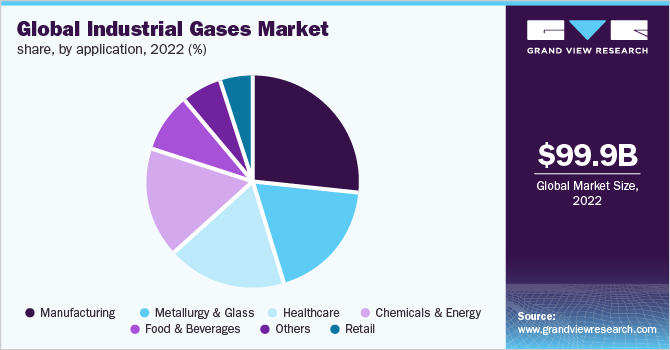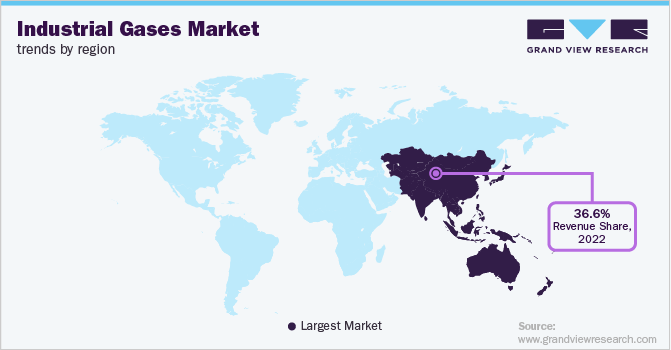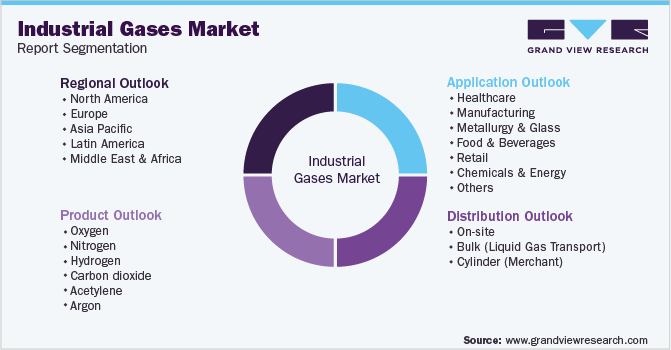- Home
- »
- Petrochemicals
- »
-
Industrial Gases Market Size, Share & Growth Report, 2030GVR Report cover
![Industrial Gases Market Size, Share & Trends Report]()
Industrial Gases Market Size, Share & Trends Analysis Report By Product (Nitrogen, Oxygen), By Application (Healthcare, Manufacturing, Retail), By Distribution (Bulk, Cylinder), And Segment Forecasts, 2023 - 2030
- Report ID: GVR-4-68038-468-0
- Number of Report Pages: 149
- Format: PDF, Horizon Databook
- Historical Range: 2018 - 2021
- Forecast Period: 2023 - 2030
- Industry: Bulk Chemicals
Report Overview
The global industrial gases market size was valued at USD 99.99 billion in 2022 and is expected to grow at a compound annual growth rate (CAGR) of 7.42% from 2023 to 2030. The growth is primarily driven by the growing manufacturing industry in developing economies of the Asia Pacific region. Rapid industrialization and application of industrial gases in various industries, such as manufacturing, mining, metals, food & beverage, and healthcare, are further expected to influence the market growth in the coming years. However, environmental regulations, safety, and high gas conversion costs may hinder the industry growth during the forecast period.

The U.S. accounted for a majority share in the North America regional market and is expected to retain its leading position throughout the forecast period. The U.S. emerged as one of the major countries utilizing industrial gases, as the country has the presence of a large number of major industrial gas suppliers, such as Linde, Air Liquide, Messer, and Air Products & Chemicals. The growing healthcare industry in the U.S., coupled with growing R&D in the healthcare sector owing to the recent outbreak of the COVID-19 pandemic, is expected to propel the demand for industrial gases in the U.S.The dependence of the electronics end-use sector on industrial gases has provided an alternate source of opportunity for the market, given the broad range of applications from flat-panel displays and semiconductors to LED lights and solar cells. Unlike the petrochemical and metallurgy industry, the electronics end-use industry embraces suppliers to greater standards with regard to project experience, coverage, and technical specifications. Asia Pacific accounted for a significant revenue share in 2022 and is projected to continue to dominate the global market during the forecast period. The economic growth in countries, such as China, India, and South Korea, has shown strong growth and the trend is expected to continue during the forecast period. The presence of major electronics companies in the U.S. is also one of the major reasons driving the demand for industrial gases. In the U.S., the usage of electronics is increasing day by day, with an ever-growing number of electronic devices and gadgets being manufactured for the convenience of consumers. The growing healthcare and electronic industries across the region are likely to promote market growth. Expansion of the industrial sector is anticipated to further fuel the regional market.
Product Insights
On the basis of products, the global industry has been further categorized into oxygen, nitrogen, hydrogen, carbon dioxide, acetylene, and argon. The oxygen product segment dominated the industry in 2022 and accounted for the highest share of 28.43% of the overall revenue. Oxygen is utilized for fabrication, steel melting, medical applications, copper smelting, etc. Oxygen is known to improve the thermal efficiency of fuel. Thus, oxygen can be used as a methodology for obtaining better energy from fuel.
Similarly, it can also be used for the cleanup of hazardous, treatment of polluted water, and coal gasification systems. It is considered an alternative to chlorine in the pulp & paper industry to decrease pollution. Nitrogen has the highest growth rate and penetration owing to large-scale applications in the medical and pharmaceutical industries. The global pandemic has resulted in healthcare facilities demanding essential medical supplies and other essential life-saving devices to prevent the spread of the virus and provide optimum care to infected patients.
Distribution Insights
The cylinder segment led the industry in 2022 and accounted for the largest revenue share of 36.55%. It is the most preferred form of distribution by consumers. This type of distribution is practiced by independent gas distributors by purchasing gas from producers and compressing them in their packaging facilities. Many gases are also supplied at room temperature in the liquid state. The gases are stored at low pressure in thin-walled steel or composite aluminum cylinders. The bulk (Liquid Gas Transport) distribution segment accounted for the second-largest share in 2022. This involves the gas in a liquefied or natural state being transported by either road (dedicated trailers) or via pipelines (over long distances).
This mode of delivery ideally opts when the demand for gases is higher than packaged gas distribution and lesser than onsite distribution. This is a more efficient form of distribution and is, therefore, more preferred than the other modes of distribution since it ensures a continuous supply of gases. The onsite form of distribution is the most conducive form of distribution for the manufacturing companies like Air Products & Chemicals, The Linde Group, Air Liquide, etc. since it reduces their transportation costs. The company’s onsite plant usually integrates onsite facilities at refueling stations to optimize its operations. The supply systems are set up around standardized components to ensure maximum cost efficiency.
Application Insights
The manufacturing industry application segment accounted for the largest share of 27.05% of the overall revenue in 2022 and is projected to grow at the second-highest CAGR during the forecast period. The demand for industrial gases in the manufacturing industry is projected to witness rapid growth owing to various applications. Carbon dioxide is frequently used in the rubber industry in the form of dry ice for the non-abrasive cleaning of rubber molds. It is commonly used by manufacturers of molded rubber products to reduce production downtime and maintenance & labor costs. The use of carbon dioxide for the cleaning of essential tools and molds in the rubber industry offers various advantages over conventional cleaning methods.

Healthcare is estimated to be the fastest-growing segment from 2023 to 2030. Governments across the globe are investing in medical research as medical institutes and pharmaceutical companies are working towards developing vaccines and medicine to fight novel coronavirus. This is driving the demand for industrial nitrogen, which is used in the healthcare industry. Carbon dioxide is also widely used for cryopreservation applications, where tissues, gametes, cellular samples, and embryos are preserved at extremely low temperatures. Industrial gases also find application in various other industries including automotive & transportation, aerospace & aircraft, water & wastewater treatment, and others.
Regional Insights
On the basis of geographies, the global industry has been further categorized into Asia Pacific, North America, Europe, Latin America, and Middle East & Africa. Asia Pacific dominated the industry at 36.64% in 2022, in terms of revenue share, and is expected to be the fastest-growing region with a CAGR of 9.8% over the forecast period. The growth and expansion of end-use industries in key markets like India, China, South Korea, and Japan are expected to drive the demand for industrial gases in the region.

China is the largest country market in the APAC regional market owing to increasing demand for industrial gases in the aerospace industry for high-quality gas solutions. Growth and expansion of the food & beverage and industrial sectors in key markets like China and India are also expected to fuel the demand for industrial gases over the forecast period. In 2022, North America accounted for the second-largest revenue share. The growing healthcare industry and expansion of the industrial sector in the U.S. and Canada are expected to foster the demand for industrial gases in the region.
Key Companies & Market Share Insights
The global industry is highly competitive due to the strong presence of many regional as well as multinational companies. Key industry participants are involved in research and development and constant innovation, which have become among the most important factors for them to perform in the competitive industry. Some of the prominent players operating in the global industrial gases market are:
-
Air Liquide
-
Air Products Inc.
-
INOX-Air Products Inc.
-
Iwatani Corp.
-
Linde plc
-
Messer
-
SOL Group
-
Strandmøllen A / S
-
Taiyo Nippon Sanso Corp.
Industrial Gases Market Report Scope
Report Attribute
Details
Market size value in 2023
USD 105.08 billion
Revenue forecast in 2030
USD 173.43 billion
Growth rate
CAGR of 7.42% from 2023 to 2030
Base year for estimation
2022
Historical data
2018 - 2021
Forecast period
2023 - 2030
Quantitative units
Revenue in USD million/billion, volume in million SCF, and CAGR from 2023 to 2030
Report coverage
Revenue forecast, volume forecast, company ranking, competitive landscape, growth factors, and trends
Segments covered
Product, application, distribution, region
Regional scope
Asia Pacific; North America; Europe; Latin America; MEA
Country scope
U.S.; Canada; Mexico; U.K.; Germany; France; Italy; Spain; The Netherlands; China; India; Japan; South Korea; Australia; Malaysia; Thailand; Singapore; Brazil; Saudi Arabia; UAE
Key companies profiled
Air Liquide; Linde plc; Air Products Inc.; Taiyo Nippon Sanso Corp.; Messer; SOL Group; Iwatani Corp.; Matheson Tri-Gas, Inc.; INOX-Air Products Inc.; Strandmøllen A/S
Customization scope
Free report customization (equivalent up to 8 analyst’s working days) with purchase. Addition or alteration to country, regional, and segment scope.
Pricing and purchase options
Avail customized purchase options to meet your exact research needs. Explore purchase options
Global Industrial Gases Market Segmentation
This report forecasts revenue growth at global, regional, and country levels and provides an analysis of the latest industry trends in each of the sub-segments from 2018 to 2030. For the purpose of this study, Grand View Research has segmented the global industrial gases market report based on product, application, distribution, and region:

-
Product Outlook (Volume, Million SCF; Revenue, USD Million, 2018 - 2030)
-
Oxygen
-
Nitrogen
-
Hydrogen
-
Carbon dioxide
-
Acetylene
-
Argon
-
-
Application Outlook (Volume, Million SCF; Revenue, USD Million, 2018 - 2030)
-
Healthcare
-
Manufacturing
-
Metallurgy & Glass
-
Food & Beverages
-
Retail
-
Chemicals & Energy
-
Others
-
-
Distribution Outlook (Volume, Million SCF; Revenue, USD Million, 2018 - 2030)
-
On-site
-
Bulk (Liquid Gas Transport)
-
Cylinder (Merchant)
-
-
Regional Outlook (Volume, Million SCF; Revenue, USD Million, 2018 - 2030)
-
North America
-
U.S.
-
Canada
-
Mexico
-
-
Europe
-
U.K.
-
Germany
-
France
-
Italy
-
Spain
-
The Netherlands
-
-
Asia Pacific
-
China
-
India
-
Japan
-
South Korea
-
Australia
-
Malaysia
-
Thailand
-
Singapore
-
-
Latin America
-
Brazil
-
-
Middle East & Africa
-
Saudi Arabia
-
UAE
-
-
Frequently Asked Questions About This Report
b. The global industrial gases market size was estimated at USD 99.99 billion in 2022 and is expected to reach USD 105.08 billion in 2023.
b. The global industrial gases market is expected to witness a compound annual growth rate of 7.4% from 2023 to 2030 to reach USD 173.43 billion by 2030.
b. Manufacturing applications captured a market share of nearly 27.05% in 2022 of the industrial gases market owing to growing demand for advanced industrial gas in electronic industry.
b. Some of the key players operating in the industrial gases market include Air Liquide, Air Products & Chemicals, Messer Group, Taiyo Nippon Sanso, The Linde Group, among others.
b. Key factors that are driving the industrial gases market growth include rising end-user industry growth coupled with growing manufacturing industries in developing economies.
Share this report with your colleague or friend.
![gvr icn]()
NEED A CUSTOM REPORT?
We can customize every report - free of charge - including purchasing stand-alone sections or country-level reports, as well as offer affordable discounts for start-ups & universities. Contact us now
![Certified Icon]()
We are GDPR and CCPA compliant! Your transaction & personal information is safe and secure. For more details, please read our privacy policy.
We are committed towards customer satisfaction, and quality service.
"The quality of research they have done for us has been excellent."





